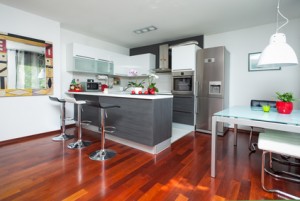 Get into the groove of sustainable living through eco-friendly kitchen floors. With the growing numbers of sustainable products, going green is definitely here to stay! And there’s no better way to start your eco-friendly lifestyle than at the heart of your home, the kitchen.
Get into the groove of sustainable living through eco-friendly kitchen floors. With the growing numbers of sustainable products, going green is definitely here to stay! And there’s no better way to start your eco-friendly lifestyle than at the heart of your home, the kitchen.
Making green choices can seem overwhelming, especially with the growing options for eco-friendly products. To help you determine which products are right for you and your home, here are some popular flooring options.
1. Wood Flooring
When it comes to eco-friendly flooring materials, wood is undeniably still the leading choice. It is a timeless, warm and versatile material that adds value to your home. One option is to use laminated wood with recycled wood fibers. This usually comes with 90 percent recycled wood fibers and 100 percent recycled polyethylene for its underlayment, which will reduce heat transfer between kitchen and basements. Another eco-friendly option is to use reclaimed wood. Do not use wood products with added formaldehyde, which is usually found in engineered or pressed wood for backing or sublayers. Opt for distributors who offer low-VOC sealers and cleaners.
Why is wood flooring sustainable?
- Wood comes from a renewable source, assuming there is sustainable management of forests and plantations.
- Almost no waste is produced since dust, bark and trims are gathered to fuel wood production facilities.
- Compared to concrete and steel, wood requires less energy to produce.
2. Bamboo Flooring
Certified as a sustainable material, bamboo is a highly recommended material for your eco-friendly kitchen floors. Bamboo is denser than oak, and laminated bamboo floors won’t warp or expand easily. This eliminates the creaking sound that occurs when wood floor planks compress. Bamboo’s distinctive appeal, tightness of grain and uniformity of color create a desirable and flexible material for any kitchen style. Being moisture resistant and durable makes it an even more workable material for kitchens.
If you love warm shades of brown, then bamboo flooring is a great choice as it comes either in its natural light color or in a darker honey-brown color. Honey-colored bamboo flooring has undergone carbonization, during which the material is subjected to steam and pressure, causing the fibers to darken. The darker the shade of bamboo, the longer it has been subjected to carbonization.
Why is bamboo flooring sustainable?
- Bamboo comes from a renewable source and can be grown and harvested faster compared to hardwood.
- According to Bamboocentral.org, bamboo forests can give off 35 percent more oxygen than a group of hardwood trees.
- It does not need fertilizers or pesticides to grow as it is naturally resistant to mildew and insects. This attribute is also seen even after bamboo is made into planks.
3. Cork Flooring
Cork is one of the most comfortable and beautiful materials for floorings. Although it may not be a glamorous option, it can be manufactured to simulate hardwood floors. If you’re looking for a low maintenance type of eco-friendly kitchen flooring, cork is a perfect fit.
The material can also be made into a variety of colors to mix and match. Plus it’s a healthy option for your kitchens for its anti-microbial, anti-fungal and hypoallergenic properties.
Why is cork flooring sustainable?
- As a softwood material from the cork oak tree, it is harvested without cutting the tree down.
- You do not need regular adhesives or nails when installing cork flooring.
- Cork flooring is usually from recycled cork, and the flooring itself can be reused or recycled.
Other Eco-Friendly Flooring Options
Other options to consider are natural stone, linoleum and tiles. Recycled, reclaimed or salvaged stone or wood are also good picks. Innovative and high-tech floors are also great options to look at. Ariostea has recently released their 4.7 high-tech tiles, which can be used as a second skin for floors or even walls. It is ecological by nature and fully recyclable. Switching to eco-friendly kitchen floors can be an easy and cost-effective choice – all you have to lose are the pollutants.
